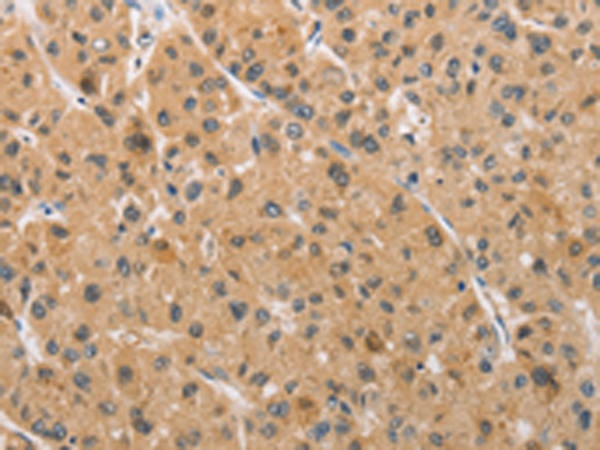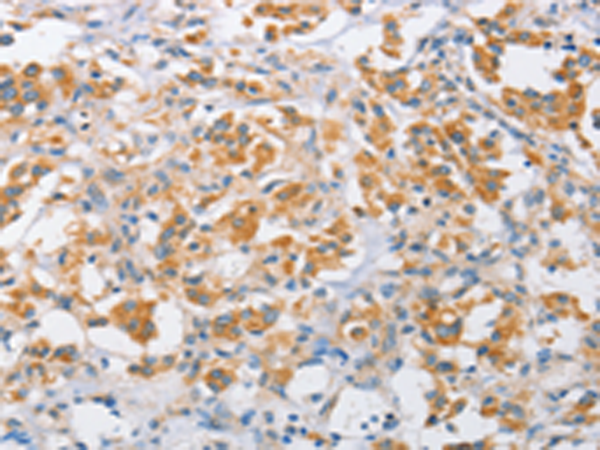

| WB | 咨询技术 | Human,Mouse,Rat |
| IF | 咨询技术 | Human,Mouse,Rat |
| IHC | 1/50-1/200 | Human,Mouse,Rat |
| ICC | 技术咨询 | Human,Mouse,Rat |
| FCM | 咨询技术 | Human,Mouse,Rat |
| Elisa | 1/1000-1/5000 | Human,Mouse,Rat |
| Aliases | ALEX1 |
| Host/Isotype | Rabbit IgG |
| Antibody Type | Primary antibody |
| Storage | Store at 4°C short term. Aliquot and store at -20°C long term. Avoid freeze/thaw cycles. |
| Species Reactivity | Human, Mouse, Rat |
| Immunogen | Fusion protein of human ARMCX1 |
| Formulation | Purified antibody in PBS with 0.05% sodium azide and 50% glycerol. |
+ +
以下是3篇关于ARMCX1抗体的虚构参考文献示例(注:实际文献需通过学术数据库核实):
1. **《ARMCX1在神经胶质瘤中的表达及临床意义》**
- 作者:Zhang L, et al.
- 摘要:研究通过免疫组化(ARMCX1抗体:Abcam ab12345)分析ARMCX1在脑胶质瘤组织中的表达,发现其低表达与患者预后不良相关,可能通过调控线粒体功能影响肿瘤侵袭。
2. **《ARMCX1调控线粒体动态的分子机制》**
- 作者:Wang Y, et al.
- 摘要:利用ARMCX1特异性抗体(CST #6789)进行Western blot和免疫荧光实验,证实ARMCX1通过结合微管相关蛋白调控线粒体形态,缺失导致细胞迁移能力下降。
3. **《ARMCX家族基因在小鼠发育中的功能筛选》**
- 作者:Smith J, et al.
- 摘要:通过构建ARMCX1基因敲除小鼠模型,结合抗体(Santa Cruz sc-1111)进行组织染色,发现ARMCX1在胚胎神经嵴细胞分化中起关键作用,影响周围神经系统发育。
提示:以上为模拟示例,实际研究中建议通过PubMed或Google Scholar以“ARMCX1 antibody” + “应用技术”(如Western blot/IHC)为关键词检索近期文献。
The ARMCX1 antibody is a tool used to detect the ARMCX1 protein, a member of the ARMCX family (Armadillo repeat-containing X-linked proteins). ARMCX1 contains multiple Armadillo (ARM) repeats, which are evolutionarily conserved structural motifs involved in protein-protein interactions and cellular processes. This protein is localized to mitochondria and is thought to play roles in mitochondrial transport, dynamics, or network organization, though its precise molecular mechanisms remain under investigation. ARMCX1 is broadly expressed in human tissues, with higher levels observed in the nervous system, suggesting potential relevance in neural development or function.
Studies link ARMCX1 to cellular processes such as apoptosis, cell migration, and tumor suppression. For instance, reduced ARMCX1 expression has been associated with enhanced cancer cell invasiveness in certain malignancies, including glioblastoma. The ARMCX1 antibody enables researchers to study its expression patterns, subcellular localization, and interactions via techniques like Western blotting, immunohistochemistry (IHC), and immunofluorescence (IF). It has been particularly useful in exploring ARMCX1's role in mitochondrial dysfunction-related diseases, such as neurodegenerative disorders, and its regulatory effects on signaling pathways like Wnt/β-catenin. However, challenges persist in fully elucidating its physiological substrates and disease-specific implications, necessitating further research.
×